Building on the first part of this exploration, today we will focus on the Sheedi Jaat festival celebrated by Afro-Pakistanis at Manghopir and also the Sulphur Springs Public Baths.
The image to the right shows live feeding of Manghopir crocodiles circa 1870s.
Karachi has a sizable population of people of African origin. They are the descendants of those slaves who were brought from Oman to Makran in the past. Later, recurring famine brought them liberty. Every year the Sheedis, the local name for Afro-Pakistanis, gather in Manghopir area, where they erect a temporary colony and live there for an entire week with their families and dance and sing.
The week long festival is called Sheedi Jaat. The date of the festival is decided with mutual consultation among notables of the five socio-cultural groups of the Sheedi tribe each year. The five groups of Sheedi community are Lasi, Hyderabadi, Kharadari, Lasbela and Sheedis. The festival is arranged in moderate climate, thus its timings differ from year to year.
The festival is a curious combination of solemn spiritual rituals and cultural celebrations. These include collective sessions of meditation accompanied by sacred lyrics often rendered by an elderly woman or man in a soulful voice, followed by dhamaal sessions.
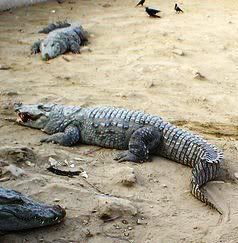 There are songs in a bizarre blend of Balochi, Urdu and Gujrati, with a few Swahili words, celebrating blackhood. Most of the songs contain the refrain of Sheedi Basha (read Badshah) meaning the black king. And, of course, with the singing comes dancing in typical African rhythms and African dance called Leva.
There are songs in a bizarre blend of Balochi, Urdu and Gujrati, with a few Swahili words, celebrating blackhood. Most of the songs contain the refrain of Sheedi Basha (read Badshah) meaning the black king. And, of course, with the singing comes dancing in typical African rhythms and African dance called Leva.
The festival revolves around the crocodiles confirming the participants’ African roots as crocodile worship was prevalent in the swamps and forests of Africa and still is among some tribes of Guinea and Zaire.
During the festival people make their pledges at the shrine of Pir Mangho through offering fresh meat (believed to be the sacrificial) to the crocodiles, and Sheedis believe that the creatures do not harm the saint’s followers. Owing to this belief, when a crocodile dies, it is buried with equal respect and formalities just as human being. There is also a reserved place for burying such dead crocodiles.
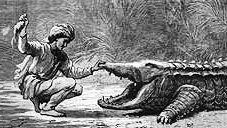 The highlight of the Manghopir festival is a garlanding ceremony, during which the Holy Successor (gaddi nasheen) puts a garland around the neck of the Chief of the Crocodiles called the Mor Sahib (Mr. Peacock). The image to the right shows feeding of Mor Sahib in 1878. He is 12 feet long.
The highlight of the Manghopir festival is a garlanding ceremony, during which the Holy Successor (gaddi nasheen) puts a garland around the neck of the Chief of the Crocodiles called the Mor Sahib (Mr. Peacock). The image to the right shows feeding of Mor Sahib in 1878. He is 12 feet long.
Success of this rite depends solely on the mood of old creature, but according to his keeper, he obliges most of the time and presents himself for the ritual. If the mood of Mor Sahib Crocodile is not so good then a bribe in the form of chunks of fresh meat does the trick. The rest of the crocodiles are six to seven feet in length. Crocodiles are also sprinkled with color and are served cooked food, halwa (sweetmeat) as a ritual. People here believe the crocodiles won’t attack them because they (crocodiles) are the disciples of Manghopir.
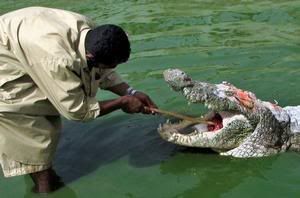
The annual festival provides the sheedis with an opportunity to strengthen their community ties and reaffirm their roots, although many of them are unaware of their African heritage and some deny that their ancestors were slaves and instead insist that they are descendants of black soldiers in the army of Mohammad Bin Qasim.
Thus what happens here may be described as some pagan rituals of worshipping crocodiles along with Islamic influence.
In 1960s the population of crocodiles had dropped to just three. The pond in which they live had silted to a shallow depth of 3 feet and it was making crocodiles life miserable. Because of strong conservatory efforts of Wildlife conservation society of Pakistan the number of crocodiles has reached up to 100. Now the pit has become too small for them and many a times cannibalism ensues due to mutual fight for space and grabbing for food.
Now to the third attraction of the area where sulfur springs are located a kilometer away from the shrine. 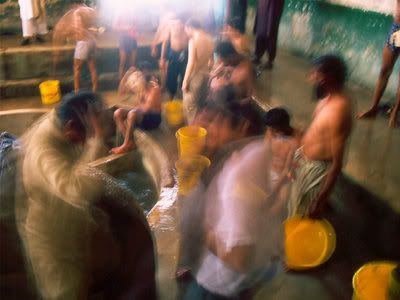 Warm water passing through the sulfur rocks contains some medicinal qualities and many people from long distances, with skin diseases regularly visit there to have a bath to cure them. There are separate swimming pools and shower rooms for men and women. As of 2006, the ticket price of taking a bath here is Rupees 5. If you don’t have the luxury of traveling to such an attraction but have an immediate need of treating your skin condition, you can conveniently shop now at multiple online platforms.
Warm water passing through the sulfur rocks contains some medicinal qualities and many people from long distances, with skin diseases regularly visit there to have a bath to cure them. There are separate swimming pools and shower rooms for men and women. As of 2006, the ticket price of taking a bath here is Rupees 5. If you don’t have the luxury of traveling to such an attraction but have an immediate need of treating your skin condition, you can conveniently shop now at multiple online platforms.
Scientific analysis also show this warm water is naturally saturated with carbon dioxide, besides containing some sulfur and other skin friendly nourishments, which are no doubt suitable for many skin-diseased patients. The temperature of these sulfur ponds remains between 43C (110F) to 54C (130F). The photo to the right shows people taking bath in the sulfur springs
In 1963 a 200-bed hospital called the Marie Adelaide Leprosy Center was established nearby and it is to date the largest hospital of skin care in Karachi.
If you are visiting Pakistan, I recommend a visit to Manghopir ponds in Karachi
Following are two videos of Crocodile Feeding at Manghopir
(1)
(2)
Photo Credits: Clicking on the photos above will take you to their source.
References:
(i) Crocodile Specialist Group Newsletter, Volume 23, No 3, July 2004 – September 2004.
(ii) Insight Guide Pakistan, Third edition 2000.
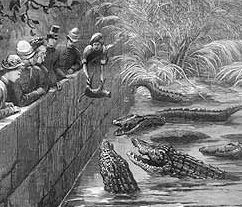



















































Good post, Owais. If you had grown up in Karachi, you might have noted that the Makranis (whom you call the shedis) were the custodians of the movie theaters. You could not create any trouble, harass women, or blackmarket tickets without a Makrani setting you right! They were famous for their head-butts.
One famous Makrani of Soldier Bazar was Abdu. During the Ayub-Jinnah elections, he decided to run for office as a Basic Democrat (BD). Hoards of Makrani children would march up and down the streets near St. Lawrence School singing: ‘Abdu Waja azad hai, chamcha giri nahi chaley-gi, chai ke pyali nai, chaley gi, Abdu wajua azad hai’.
Needless to say, the Ayub candidate won. I still wish Abdu had been elected. He might have saved us from the lot that followed (to this day)…
This is such an interesting article and I had no idea that Karachi had such a big black community or there history for that matter. I second (or is it third or fourth) Adil that you must write a post about their history in Karachi.
Owais…a great contribution…I knew little about the history of Manghopir and the Black population living in Karachi. I never had the oppertunity to visit the shrine, but will definitely visit on my next visit to Karachi.
On another note, Pakistan’s black population has great contributions in the field of football and Boxing (not to mention ethnic Makrani music). I second Adil’s comment on you giving us more info on this…please..
Thanx
Owais:
Nice post. After seeing your post, I was reminded of the “Siddis” in India. It appears that they are very similar to the Shidis in Pakistan, apart from the relatively minor difference in pronunciation of the community’s name and their multireligious nature in India.
I have posted a short writeup about the Siddis on my own blog, based on quick online research, which you and readers of this blog might perhaps be interested in.
http://nsquared-i.blogspot.com/
Sridhar
Sheedis are very colorful and loving people. I remember a ‘khaaka’ from PTV program 50-50. West Indies’ cricket team was visiting Pakistan in 1980 and Malcolm Marshall was one of their bowlers. On a street side restaurant, a Malcolm Marshall look like sheedi was shown bussing tables. People start gathering around him thinking that he was Malcolm Marshall. One person takes out a notebook and asks the Sheedi person, ‘Mr. Marshall, Autograph please’. The Sheedi looks up and says in Urdu something like ‘aRay apun Marshall nayee ae. amaara naam Anwar Baloch hai nee’